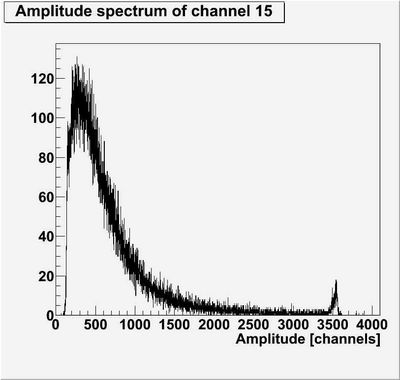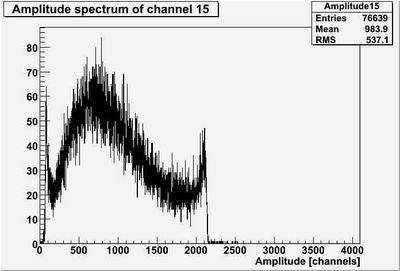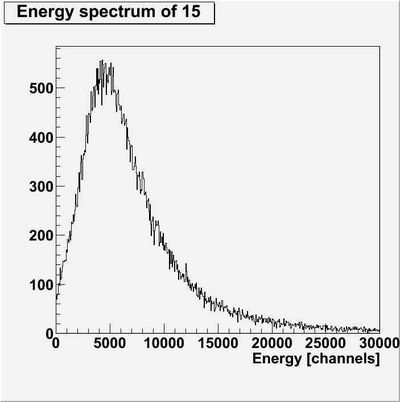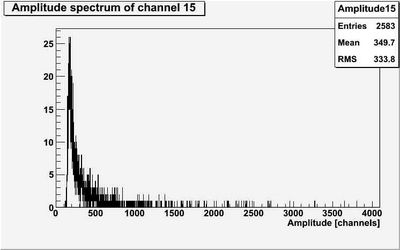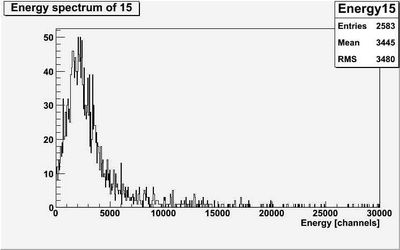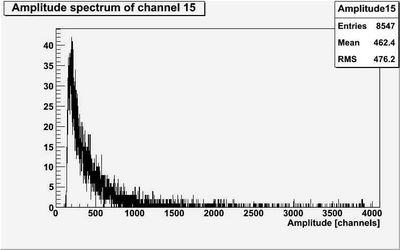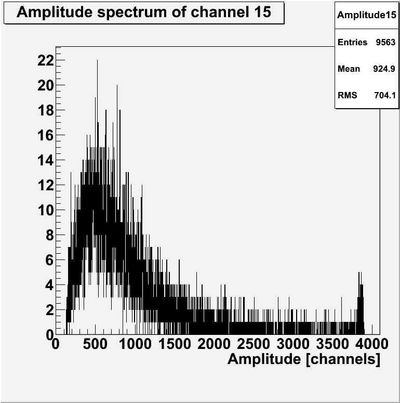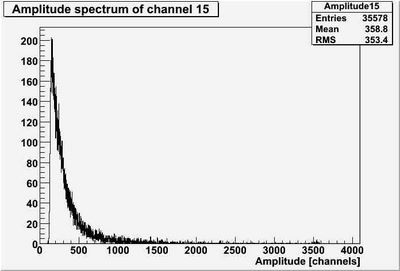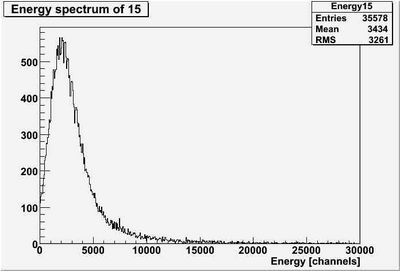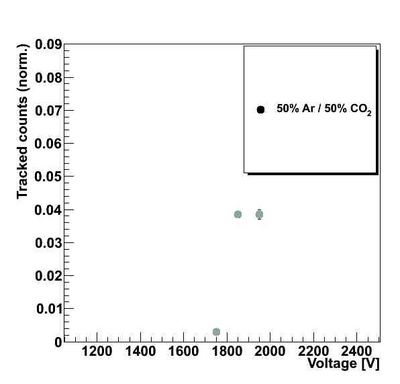Difference between revisions of "ASIC meeting June 14, 2010"
(→Performance Plots for the ASIC) |
(→Measurements of the Fe-55 Source) |
||
| (28 intermediate revisions by 3 users not shown) | |||
| Line 14: | Line 14: | ||
== Agenda == | == Agenda == | ||
| − | + | ===Status of the new ASIC=== | |
| − | ===Performance Plots for the ASIC=== | + | ====CDC Reasons for Changes to the old ASIC==== |
| + | In the detailed studies that were carried out with the older preamplifier, it was determined that to be able to have the needed dynamic range to carry out dE/dx, it was necessary to reduce the gain of the older ASIC by a factor of between 3 and 5, leaving all other parameters the same. This included the maximum voltage (which was ~1V). This improved dynamic range was matched to the noise in the old ASIC, the size of pulses seen for Fe-55 and cosmics, and those then predicted for kaons and protons when running GlueX. This was also based on our efficiency plot using cosmics for the planned gas mixture which showed that the operating plateau started at about 2100V. | ||
| + | ====Performance Plots for the ASIC at CMU ==== | ||
The following links go to pages that compare the performance of the older preamplifier | The following links go to pages that compare the performance of the older preamplifier | ||
to the newest version of the ASIC. We note that the interposer board was not used for the | to the newest version of the ASIC. We note that the interposer board was not used for the | ||
older preamplifier and that the Struck FADCs we have at CMU are set to a scale such that | older preamplifier and that the Struck FADCs we have at CMU are set to a scale such that | ||
| − | 1 volt | + | 1 volt corresponds to about 4000 channels. We note that the new preamplifier does not exceed |
| − | ~2000 | + | ~2000 channels here because the output voltage is now (apparently) limited to 0.5V. |
*[[Preamp 4|Preamp 4 : Comparison of scope traces with earlier preamps]] | *[[Preamp 4|Preamp 4 : Comparison of scope traces with earlier preamps]] | ||
The following sets of plots were taken simply by swapping the old and new preamplifier on the | The following sets of plots were taken simply by swapping the old and new preamplifier on the | ||
| − | CDC. The high | + | CDC. The high voltage settings were the same and the gas mixture were the same for both. For the |
case of the cosmics with a <i>reduced</i> gain in the new ASIC, we would expect the location of the | case of the cosmics with a <i>reduced</i> gain in the new ASIC, we would expect the location of the | ||
minimum ionizing peak for cosmics to go down by about a factor of three. Oddly, by just about any reasonable measure, it has moved up. We find this extremely confusing. | minimum ionizing peak for cosmics to go down by about a factor of three. Oddly, by just about any reasonable measure, it has moved up. We find this extremely confusing. | ||
*[[Preamp 4: Comparison of cosmic data with original preamp]] | *[[Preamp 4: Comparison of cosmic data with original preamp]] | ||
| + | 2050V - cosmics - max amplitude histogram | ||
| + | {| border="1" cellpadding="2" | ||
| + | |width="415pt"|[[Image:cosmic_amplitude_2050V_old_preamp.jpg|thumb|none|400px|old preamp, cosmics, amplitude, 50/50 Ar/CO2, 2050V]] | ||
| + | |width="415pt"|[[Image:cosmic_amplitude_2050V_preamp4.jpg|thumb|none|400px|new preamp, cosmics, amplitude, 50/50 Ar/CO2, 2050V]] | ||
| + | |} | ||
| + | 2050V- cosmics - energy | ||
| + | {| border="1" cellpadding="2" | ||
| + | |width="415pt"|[[Image:cosmic_energy_2050V_old_preamp.jpg|thumb|none|400px|old preamp, cosmics, energy, 50/50 Ar/CO2, 2050V]] | ||
| + | |width="415pt"|[[Image:cosmic_energy_2050V_preamp4.jpg|thumb|none|400px|new preamp, cosmics, energy, 50/50 Ar/CO2, 2050V]] | ||
| + | |} | ||
| + | The following plots are taken with the Fe-55 source for the same pairs of configuration. Here we are limited by a great deal of overflow and saturation in both cases so it is difficult to draw a strong conclusion on where the gain really is on the new ASIC | ||
*[[Preamp 4: Comparison of 55Fe data with original preamp]] | *[[Preamp 4: Comparison of 55Fe data with original preamp]] | ||
| − | ===Efficiency Plots for the CDC=== | + | ====Efficiency Plots for the CDC==== |
The following plot is taken from our NIM article that shows the chamber efficiency as a function of the high voltage setting for various gas mixtures. As can be seen, for the optimal gas mixture | The following plot is taken from our NIM article that shows the chamber efficiency as a function of the high voltage setting for various gas mixtures. As can be seen, for the optimal gas mixture | ||
(around 50/50), the plateau starts at about 2100 V and there is no efficiency below around 1900V. | (around 50/50), the plateau starts at about 2100 V and there is no efficiency below around 1900V. | ||
| Line 38: | Line 51: | ||
|} | |} | ||
| + | === Status from the FDC === | ||
| + | ====gas gain==== | ||
| + | ====efficiency==== | ||
| + | ====plateau==== | ||
| + | ====amplitude and energy histograms with cosmics & Fe-55==== | ||
| + | ====scaling to experiment==== | ||
| + | === Remaining tests === | ||
| + | * At CMU, we are in the process of repeating the efficiency measurements with the new ASIC to see if the combination of the reduced noise and apparent increased gain could be mapped onto the appropriate dynamic range for the CDC. It takes at least a week to collect the cosmic data, and then sometime to analyze. | ||
| − | + | * We have changed the input range of the fADCs to accept signals from 50mV to 600 mV (approximately) - this is half of the previous range. We adjusted the shaper output correspondingly, to put the lowest baseline voltage at around 80 mV (it varies from straw to straw). This process takes a while to do, so we can no longer switch between preamps so easily. | |
| + | |||
| + | * So far we have collected cosmic data at 1750V, 1850V and 1950V, for around 20 hours at each voltage. These (minimalist) results are shown below, and also here: [[Preamp_4:_Quick_look_at_cosmic_data_with_reduced_fADC_range]] | ||
| + | |||
| + | * The following show untracked data (hits in multiple straws are not required) so that they can be compared to the earlier spectra (remembering that the fADC range is now half of that used previously): | ||
| + | <br> | ||
| + | 1750V (19.5h) amplitude (left) and energy (right) | ||
{| border="1" cellpadding="2" | {| border="1" cellpadding="2" | ||
| − | |width="415pt"|[[Image: | + | |width="415pt"|[[Image:newprerange_50-50-1750V_amp.jpg|thumb|none|400px|new preamp, new fadc range (=1/2 old one), amplitudes, 50/50 Ar/CO2, 1750V]] |
| − | |width="415pt"|[[Image: | + | |width="415pt"|[[Image:newprerange_50-50-1750V_ener.jpg|thumb|none|400px|new preamp, new fadc range (=1/2 old one) , energy, 50/50 Ar/CO2, 1750V]] |
| + | |} | ||
| + | <br> | ||
| + | 1850V (24h) amplitude (left) and energy (right) | ||
| + | {| border="1" cellpadding="2" | ||
| + | |width="415pt"|[[Image:newprerange_50-50-1850V_amp.jpg|thumb|none|400px|new preamp, new fadc range (=1/2 old one), amplitudes, 50/50 Ar/CO2, 1850V]] | ||
| + | |width="415pt"|[[Image:newprerange_50-50-1850V_ener.jpg|thumb|none|400px|new preamp, new fadc range (=1/2 old one) , energy, 50/50 Ar/CO2, 1850V]] | ||
| + | |} | ||
| + | <br> | ||
| + | 1950V (18h?) amplitude (left) and energy (right) | ||
| + | {| border="1" cellpadding="2" | ||
| + | |width="415pt"|[[Image:newprerange_50-50-1950V_amp.jpg|thumb|none|400px|new preamp, new fADC range (=1/2 old one), amplitudes, 50/50 Ar/CO2, 1950V]] | ||
| + | |width="415pt"|[[Image:newprerange_50-50-1950V_ener.jpg|thumb|none|400px|new preamp, new fADC range (=1/2 old one) , energy, 50/50 Ar/CO2, 1950V]] | ||
|} | |} | ||
| − | + | <br> | |
| − | + | And with the original preamp and ADC range for comparison: | |
| − | + | 1950V - amplitude (left) and energy (right) | |
{| border="1" cellpadding="2" | {| border="1" cellpadding="2" | ||
| − | |width="415pt"|[[Image: | + | |width="415pt"|[[Image:oldpreamp_50-50-1950V_amp.jpg|thumb|none|400px|old preamp, old fADC range, amplitudes, 50/50 Ar/CO2, 1950V]] |
| − | |width="415pt"|[[Image: | + | |width="415pt"|[[Image:oldpreamp_50-50-1950V_ener.jpg|thumb|none|400px|old preamp, old fADC range, energy, 50/50 Ar/CO2, 1950V]] |
|} | |} | ||
| + | <br> | ||
| + | * Finally, a low statistics efficiency plot obtained with these new data (new preamp, new fADC range) for channel 7, which had the largest number of tracks going through it: | ||
| + | {| border="1" cellpadding="2" | ||
| + | |width="415pt"|[[Image:lowstateffplot.jpg|thumb|none|400px|new preamp, new fADC range (=1/2 old one), Efficiency plot or HV curve, 50/50 Ar/CO2]] | ||
| + | |} | ||
| + | This looks very promising but it would be nice to do it with more statistics and data points... | ||
| + | |||
| + | === Schedule to completion === | ||
| + | === Impact to === | ||
| + | ====detector tests ==== | ||
| + | ====to installation==== | ||
| + | |||
| + | == Meeting Follow-up == | ||
| + | ===Photographs of the Preamps=== | ||
| + | This link provides [http://www.halld.org/CDC/preamp/ pictures of the preamplifiers]. All pictures are 10 megapixel, so if you download them, they can be opened in a much higher magnification. | ||
| + | ===Measurements of the Fe-55 Source=== | ||
| + | Measurements were carried out using the Fe-55 source at lower voltage so that the signals are not saturated. These measurements show that the gain of the new preamplifer is lower than the old one, and point towards an integration time issue that we do not understand. | ||
| + | |||
| + | [[Preamp 4: Comparison of 55Fe data with original preamp at lower voltage]] | ||
| − | == | + | ===Measurements of a Tilted Chamber=== |
| + | To try and better understand the integration time issue, we will collect data with the new preamplifier and the chamber in a <i>tilted</i> configuration. The pulses tend to be even longer here because of the longer path of the track through the straw tube. The 90-degree cosmics are probably the shortest real pulse that we will be detecting in the CDC. We will try to map out if the gain ratio between the old and new preamplifier is the same for both 90-degree and tilted, or if it is continuing to change. | ||
Latest revision as of 14:01, 14 June 2010
Contents
Meeting Time and Place
Monday June 11, 2010 at 10:00am At Jefferson Lab, the meeting will be held in room F326-327
Connections
To connect from the outside, please use ESNET
1.) ESNET: 8542553
2.) Phone:
+1-800-377-8846 : US
+1-888-276-7715 : Canada
+1-302-709-8424 : International
then enter participant code: 77438230# (remember the "#")
Agenda
Status of the new ASIC
CDC Reasons for Changes to the old ASIC
In the detailed studies that were carried out with the older preamplifier, it was determined that to be able to have the needed dynamic range to carry out dE/dx, it was necessary to reduce the gain of the older ASIC by a factor of between 3 and 5, leaving all other parameters the same. This included the maximum voltage (which was ~1V). This improved dynamic range was matched to the noise in the old ASIC, the size of pulses seen for Fe-55 and cosmics, and those then predicted for kaons and protons when running GlueX. This was also based on our efficiency plot using cosmics for the planned gas mixture which showed that the operating plateau started at about 2100V.
Performance Plots for the ASIC at CMU
The following links go to pages that compare the performance of the older preamplifier to the newest version of the ASIC. We note that the interposer board was not used for the older preamplifier and that the Struck FADCs we have at CMU are set to a scale such that 1 volt corresponds to about 4000 channels. We note that the new preamplifier does not exceed ~2000 channels here because the output voltage is now (apparently) limited to 0.5V.
The following sets of plots were taken simply by swapping the old and new preamplifier on the CDC. The high voltage settings were the same and the gas mixture were the same for both. For the case of the cosmics with a reduced gain in the new ASIC, we would expect the location of the minimum ionizing peak for cosmics to go down by about a factor of three. Oddly, by just about any reasonable measure, it has moved up. We find this extremely confusing.
2050V - cosmics - max amplitude histogram
2050V- cosmics - energy
The following plots are taken with the Fe-55 source for the same pairs of configuration. Here we are limited by a great deal of overflow and saturation in both cases so it is difficult to draw a strong conclusion on where the gain really is on the new ASIC
Efficiency Plots for the CDC
The following plot is taken from our NIM article that shows the chamber efficiency as a function of the high voltage setting for various gas mixtures. As can be seen, for the optimal gas mixture (around 50/50), the plateau starts at about 2100 V and there is no efficiency below around 1900V.
Status from the FDC
gas gain
efficiency
plateau
amplitude and energy histograms with cosmics & Fe-55
scaling to experiment
Remaining tests
- At CMU, we are in the process of repeating the efficiency measurements with the new ASIC to see if the combination of the reduced noise and apparent increased gain could be mapped onto the appropriate dynamic range for the CDC. It takes at least a week to collect the cosmic data, and then sometime to analyze.
- We have changed the input range of the fADCs to accept signals from 50mV to 600 mV (approximately) - this is half of the previous range. We adjusted the shaper output correspondingly, to put the lowest baseline voltage at around 80 mV (it varies from straw to straw). This process takes a while to do, so we can no longer switch between preamps so easily.
- So far we have collected cosmic data at 1750V, 1850V and 1950V, for around 20 hours at each voltage. These (minimalist) results are shown below, and also here: Preamp_4:_Quick_look_at_cosmic_data_with_reduced_fADC_range
- The following show untracked data (hits in multiple straws are not required) so that they can be compared to the earlier spectra (remembering that the fADC range is now half of that used previously):
1750V (19.5h) amplitude (left) and energy (right)
1850V (24h) amplitude (left) and energy (right)
1950V (18h?) amplitude (left) and energy (right)
And with the original preamp and ADC range for comparison:
1950V - amplitude (left) and energy (right)
- Finally, a low statistics efficiency plot obtained with these new data (new preamp, new fADC range) for channel 7, which had the largest number of tracks going through it:
This looks very promising but it would be nice to do it with more statistics and data points...
Schedule to completion
Impact to
detector tests
to installation
Meeting Follow-up
Photographs of the Preamps
This link provides pictures of the preamplifiers. All pictures are 10 megapixel, so if you download them, they can be opened in a much higher magnification.
Measurements of the Fe-55 Source
Measurements were carried out using the Fe-55 source at lower voltage so that the signals are not saturated. These measurements show that the gain of the new preamplifer is lower than the old one, and point towards an integration time issue that we do not understand.
Preamp 4: Comparison of 55Fe data with original preamp at lower voltage
Measurements of a Tilted Chamber
To try and better understand the integration time issue, we will collect data with the new preamplifier and the chamber in a tilted configuration. The pulses tend to be even longer here because of the longer path of the track through the straw tube. The 90-degree cosmics are probably the shortest real pulse that we will be detecting in the CDC. We will try to map out if the gain ratio between the old and new preamplifier is the same for both 90-degree and tilted, or if it is continuing to change.
